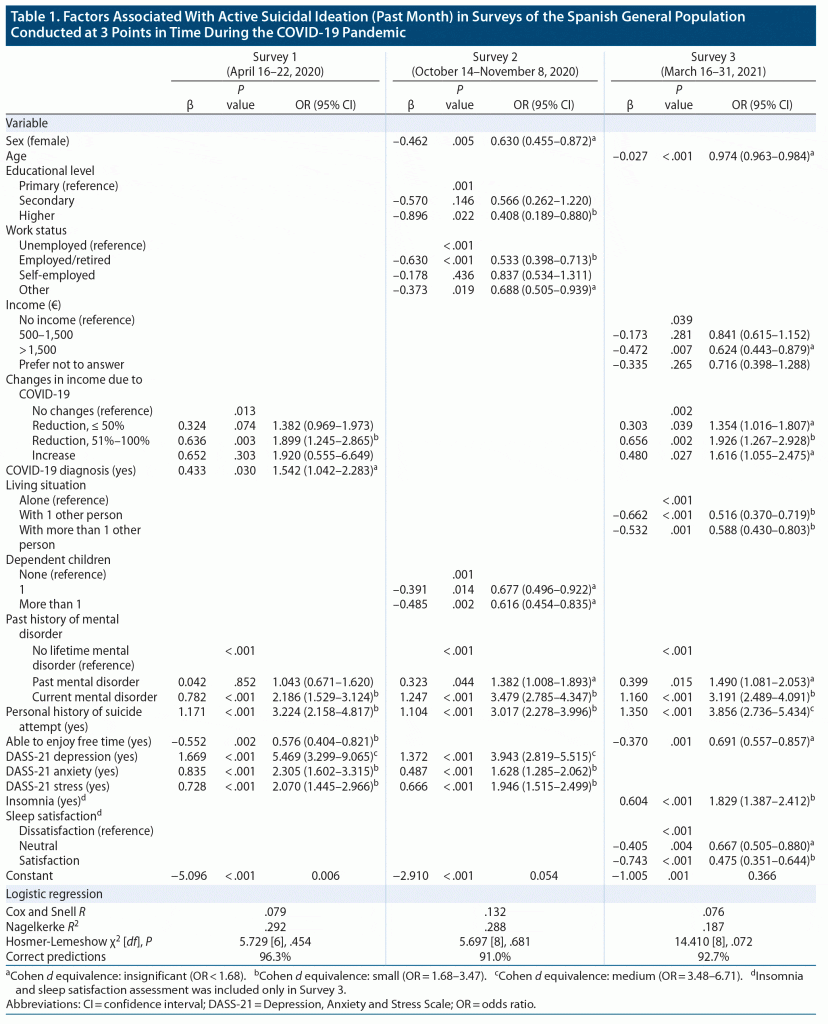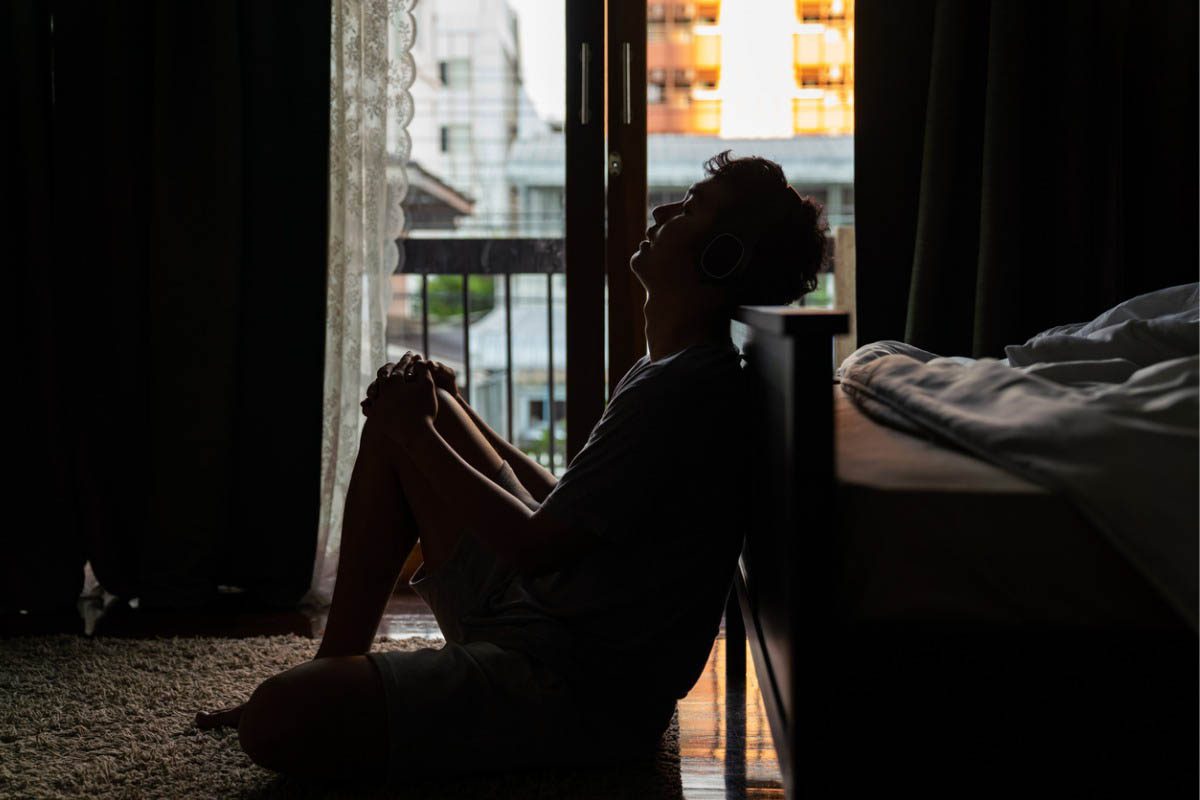
J Clin Psychiatry 2022;83(2):21br14061
To cite: Sáiz PA, Dal Santo F, García-Alvarez L, et al. Suicidal ideation trends and associated factors in different large Spanish samples during the first year of the COVID-19 pandemic. J Clin Psychiatry. 2022;83(2):21br14061.
To share: https://doi.org/10.4088/JCP.21br14061
© Copyright 2022 Physicians Postgraduate Press, Inc.
aDepartment of Psychiatry, Universidad de Oviedo, Oviedo, Spain
bCentro de Investigación Biomédica en Red de Salud Mental (CIBERSAM), Spain
cInstituto de Investigación Sanitaria del Principado de Asturias (ISPA), Oviedo, Spain
dInstituto Universitario de Neurociencias del Principado de Asturias (INEUROPA), Oviedo, Spain
eServicio de Salud del Principado de Asturias (SESPA), Oviedo, Spain
fDepartment of Psychology, Universidad de Oviedo, Oviedo, Spain
*Corresponding author: María P. García-Portilla, PhD, Department of Psychiatry-CIBERSAM, School of Medicine, University of Oviedo, Julián Clavería, s/n, 33006 Oviedo, Spain ([email protected]).
Data suggest an increased prevalence of depressive disorder and suicidal ideation (SI) (both closely connected with suicidal behavior) associated with the COVID-19 pandemic.1
The main study objective was to determine the prevalence of passive SI (PSI) and active SI (ASI) in Spanish general population surveys conducted at 3 points in time during the COVID-19 pandemic. We also characterize the main factors associated with ASI.
Methods
Three cross-sectional online surveys, designed to assess the psychological impact of the pandemic in the Spanish population 18 years and older, were conducted April 16–23, 2020 (S1: peak of first wave); October 14–November 8, 2020 (S2: peak of second wave); and March 16–31, 2021 (S3: after third wave). Study procedures were similar to those described elsewhere.2,3 Studies were conducted according to the Declaration of Helsinki, using an ad hoc sociodemographic and clinical questionnaire and the Spanish versions of the Depression, Anxiety and Stress Scale (DASS-21)4 and Paykel Suicide Scale (PSS).5 It should be noted that COVID-19 vaccination status and specific questions about sleep problems, complaints, and satisfaction were included only in S3. PSI was defined as positive answers to PSS items 1 and/or 2, and ASI, as positive answers to PSS items 3 and/or 4. In each survey, the comparison between groups (with and without ASI) was carried out using an exploratory χ2 test to establish different groups for categorical variables and a 1-way analysis of variance with a Bonferroni post hoc analysis for continuous variables. Forward stepwise regression models were estimated to determine independent factors associated with “active suicidal ideation during past month” (no/yes). Odds ratios and 95% confidence intervals were calculated. IBM SPSS Version 24.00 (IBM Corp, Armonk, NY) was used for all data analyses, and the P value was set at < .05.
Results
Sociodemographic and clinical characteristics of the samples are described in Supplementary Table 1. At S1, PSI was detected in 317 respondents (5.2%; mean [SD] age, 41.64 [14.55] years; males vs females: 76 [4.2%] vs 241 [5.6%], P = .021) and ASI in 223 respondents (3.7%; age, 39.25 [13.03]; males vs females: 54 [3.0%] vs 169 [3.9%], P = .068). At S2, PSI was detected in 1,024 respondents (16.0%; age, 32.03 [10.07]; males vs females: 69 [10.0%] vs 955 [16.7%], P < .001) and ASI in 590 respondents (9.2%; age, 31.27 [10.95]; males vs females: 57 [8.3%] vs 533 [9.3%], P = .429). At S3, PSI was detected in 590 respondents (10.4%; age, 36.69 [11.95]; males vs females: 55 [5.1%] vs 535 [11.7%], P < .001) and ASI in 415 respondents (7.3%; age, 34.89 [11.36]; males vs females: 58 [5.4%] vs 357 [7.8%], P < .007). In all surveys, subjects with PSI and ASI were younger than subjects without suicidal ideation (P < .001), and no age differences were found between subjects with PSI and those with ASI. Logistic regression models were run to assess variables associated with ASI in all surveys (Table 1).
Discussion
To our knowledge, this study is one of the first to show the evolution of SI in large Spanish population samples during the COVID-19 pandemic. Data show a high prevalence of PSI and ASI at the 3 points in time. In all surveys, the prevalence of prior-month SI was much higher than reported in the adult general population during the 12 months before (2001/2002) and after (2011/2012) the economic crisis6 (0.69% and 0.89%, respectively), and even during the very early stage of the pandemic.7 However, prior data suggest that only suicide attempts, and not SI, were more common in psychiatric admissions during the COVID-19 pandemic than before.8 The large increase in prevalence of both PSI and ASI, especially during the second and third waves, may be due to the different baseline sample characteristics, but possibly also to psychological fatigue after several months of living with COVID-19 pandemic risks and restrictions.3 Personal history of suicide attempt; current or past history of mental disorder; insomnia; DASS-21 depression, anxiety, or stress; and reduction in income (> 50%) are consistent risk factors for ASI. However, the main protective factor was being able to enjoy free time. Our data suggest that risk and protective factors are dynamic and change slightly depending on the time point and stage of the pandemic.
The main limitations are the cross-sectional online nature of the surveys, which precludes establishing causality, and the use of 3 independent convenience samples, which precludes establishing a rigorous longitudinal SI trend and does not exclude the possibility that the data reflect cohort effects. Further, the included samples are smaller than other samples recently reported. Our data suggest some risk and protective factors associated with ASI during different stages of the COVID-19 pandemic in Spain that could contribute to better adaptation of evidence-based suicide prevention strategies during and after the pandemic.9
Published online: March 7, 2022.
Author contributions: Concept and design: García-Alvarez, García-Portilla, Sáiz, and Bobes. Acquisition, analysis, or interpretation of data: All authors. Drafting of the manuscript: Sáiz. Statistical analysis: All authors. Critical revision of the manuscript for important intellectual content: All authors reviewed all drafts and gave final approval.
Potential conflicts of interest: None reported.
Funding/support: This work was partly supported by the Government of the Principality of Asturias PCTI-2018-2022 IDI/2018/235, CIBERSAM, and Fondos Europeos de Desarrollo Regional (FEDER). Financial support was also provided by Fundación para la Investigación e Innovación Biosanitaria del Principado de Asturias (FINBA).
Role of the sponsor: The funding organizations had no role in the design and conduct of the study; collection, management, analysis, and interpretation of the data; preparation, review, and approval of the manuscript; or decision to submit the manuscript for publication.
Acknowledgment: The authors thank Sharon Grevet for English assistance. Ms Grevet reports no potential conflict of interest.
Supplementary material: Available at Psychiatrist.com.
References (9)

- Czeisler MÉ, Lane RI, Petrosky E, et al. Mental health, substance use, and suicidal ideation during the COVID-19 pandemic—United States, June 24–30, 2020. MMWR Morb Mortal Wkly Rep. 2020;69(32):1049–1057. PubMed CrossRef
- García-Álvarez L, de la Fuente-Tomás L, García-Portilla MP, et al. Early psychological impact of the 2019 coronavirus disease (COVID-19) pandemic and lockdown in a large Spanish sample. J Glob Health. 2020;10(2):020505. PubMed CrossRef
- Ruiz FJ, Sáiz PA, García-Portilla MP, et al. Does COVID-19 psychological fatigue exist? results of three cross-sectional studies conducted in Spain from April 2020 to March 2021. J Glob Health. 2021. Accepted on October 22, 2021.
- Bados A, Solanas A, Andres R. Psychometric properties of the Spanish version of Depression, Anxiety and Stress Scales (DASS). Psicothema. 2005;17(4):679–683.
- Paykel ES, Myers JK, Lindenthal JJ, et al. Suicidal feelings in the general population: a prevalence study. Br J Psychiatry. 1974;124(0):460–469. PubMed CrossRef
- Miret M, Caballero FF, Huerta-Ramírez R, et al. Factors associated with suicidal ideation and attempts in Spain for different age groups. Prevalence before and after the onset of the economic crisis. J Affect Disord. 2014;163:1–9. PubMed CrossRef
- Sáiz PA, de la Fuente-Tomas L, García-Alvarez L, et al. Prevalence of passive suicidal ideation in the early stage of the coronavirus disease 2019 (COVID-19) pandemic and lockdown in a large Spanish sample. J Clin Psychiatry. 2020;81(6):20l13421. PubMed CrossRef
- Berardelli I, Sarubbi S, Rogante E, et al. The impact of the COVID-19 pandemic on suicide ideation and suicide attempts in a sample of psychiatric inpatients. Psychiatry Res. 2021;303:114072. PubMed CrossRef
- Wasserman D, Iosue M, Wuestefeld A, et al. Adaptation of evidence-based suicide prevention strategies during and after the COVID-19 pandemic. World Psychiatry. 2020;19(3):294–306. PubMed CrossRef
This PDF is free for all visitors!
Save
Cite




